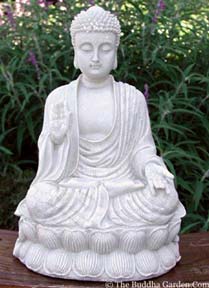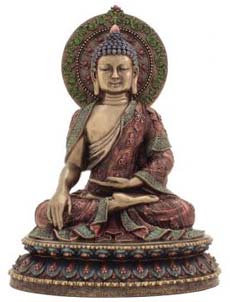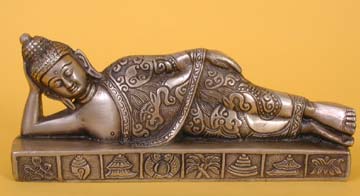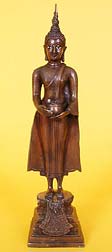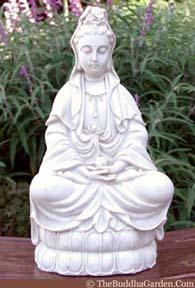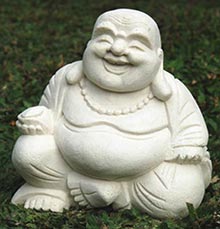If you know what to look for, you can tell the meaning of a Buddha
Statue by looking at the pose / posture, and the accompanying hand
gestures. Each traditional pose has a significance related to an
important event in the the life - or past lives - of the Historical
Buddha. (Note: You can see more examples by Visiting our Buddha Statues For Sale Page on this site.)
Also referred to as an asana or an Attitude, there are over 100
poses illustrating the life of the Buddha. And each posture will have a
specific hand gesture, called a Mudra,
associated with the posture. In general, the carvings of the Buddha
that you can buy are representations of highly venerated statues that
are enshrined at major temples throughout the world, or are
reproductions of well known sculptures that were originally commissioned
by royal patrons, and as such, their meanings and significance are
similar to the original statues.
Protection Buddha / Overcoming Fear
This depiction of a seated Buddha with the right hand raised and facing
outwards has two common meanings. The first is that of the Protection
Buddha, as the raised right hand symbolically represents a shield. The
second meaning, Overcoming Fear, is closely related to the first (since
one who is receiving protection would be less fearful).
The main features of this pose, aside from the raised right hand, is
that The Buddha can be depicted either sitting or standing, and the left
hand may either be extended outward or palm up in the lap. This statue
signifies courage and offers protection from fear, delusion and anger.
Meditation Buddha
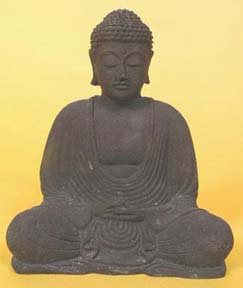
Meditation Buddha / Serenity Buddha / Calming Buddha
Another of the more common rupas is of the Buddha in Meditation. This
statue is for people who are either looking for peace and clam in their
lives, or for those who wish to improve their own meditation skills.
People will often buy a Meditation Buddha if they want to set up a
“serenity room” or a corner of their house where they can sit in calm
for a little while and unwind.
In this pose, the Buddha is depicted with both hands in the lap, face
up, and the legs are crossed, either in a Double Lotus pose (with the
ankles of each leg tucked behind one another in a locked position), or
in a Single Lotus pose (where one leg rests on top of the other leg).
Occasionally, an alms bowl is placed in the lap as well.
As this statue generally represents focused concentration, the eyes of
the Buddha are either depicted as halfway closed, or closed nearly all
the way. The silhouette of the statue is shaped - more or less - like a
triangle, which represents stability.
Many of the largest Buddha Statues in Japan, such as the Great Kamakura
Buddha Statue at Kotokuin Temple, and large statues in Korea are in the
Meditation Pose. This pose is also known as the Amithabha Buddha, which
means “Boundless Light.”
(Click To View Larger Image)
Calling The Earth To Witness / Earth Touching Buddha
The most common pose you will find in Thai temples is with the legs
crossed, the left hand in the lap, and the right hand pointing to the
ground with the palm facing inward toward the Buddha. This posture is
known as Calling The Earth to Witness, and it is the definition of the
moment of enlightenment for the Buddha.
It is the story of how the Buddha, after six years, finally was at the
verge of enlightenment. Unfortunately Mara, the Demon of Illusion, tried
to dissuade The Buddha from the final last steps. The Buddha meditated
all night to overcome the fears and temptations sent by Mara, and then
called the Earth Goddess to witness that the Buddha achieved
enlightenment in order to share with the rest of the world. Witnessing
that, the Earth Goddess wrung her hair, releasing flood waters that
swept away the Demon Mara and all the temptresses he had released.
(Click To View Larger Image)
The Nibbana Buddha / Reclining Buddha
This statue depicts the Historical Buddha in the last moments of life on
earth, prior to the Buddha dying one last time before entering Nibbana
(often written in English as ParaNibbana when referring to the life of
The Buddha). It is said that an alms giver had accidentally given the
Buddha mushroom that had gone bad, and this eventually led to the death of
the Buddha.
Because the Buddha had gained awakenment in this lifetime, the Buddha
was able to escape the endless cycle of birth - death - rebirth (known
as samsara) and was able to enter Nibbana. In this pose, the Buddha is
always depicted lying on the right hand side on top of a resting table.
One of the most well-known examples of this statue is enshrined at Wat
Pho in Bangkok, Thailand, although there are numerous other temples
throughout Southeast Asia that house statues in the posture.
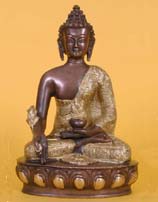 Medicine Buddha
Medicine Buddha
(Click To View Larger Image)
Medicine Buddha
The Medicine Buddha is depicted in paintings having blue skin, but
whether shown in statue or painted form, the right hand is held facing
downward with fingers extended toward the ground, palm facing outward
toward the viewer, a bowl of herbs rests in the left hand upon the lap.
It is believed by the Tibetans that the Buddha was responsible for
delivering the knowledge of medicine to the people of the world, and in
fact the right hand facing outward signifies “granting a boon” (meaning,
giving a blessing) to mankind. This is a common hand gesture amongst
both Buddhist and Hindu statues.
The Medicine Buddha is venerated by those seeking health, and is more
commonly found in the Buddhist temples and communities of Nepal and
Tibet.
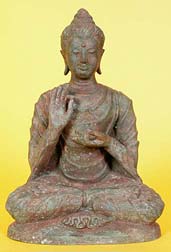
Teaching Buddha
Teaching Buddha / DhammaCakka Buddha
This statue signifies wisdom, understanding, and fulfilling destiny.
Both hands are held at chest level, with thumb and index fingers forming
a circle. The right hand is turned palm in, while the left hand is
turned palm out.
As do most images of the Buddha, the Teaching Buddha depicts a
particular moment in the life of the Buddha, namely, the first sermon
the Buddha gave after reaching Enlightenment. This sermon was to a small
group of disciples who had previously scorned the Buddha. This is a
statue that is particularly appropriate for those who are either
studying or are interested in learning more about spirituality.
The phrase DhammaCakka is hard to translate. The word Dharma means “the
way of righteousness,” while the word Cakka is usually translated as
the “Universe” or as the “cosmos.” Taken together, this phrase generally
is interpreted as, “putting the cosmic law of righteousness in order,”
or “turning the wheel of cosmic righteousness.”
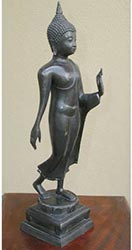 Walking Buddha
Walking Buddha
Walking Buddha / Sukhothai Buddha
Signifies grace and internal beauty, and in Thai, we call this “Phra
LeeLaa”. Right hand raised, facing outward, left hand dangles along left
side of body. Standing with right foot behind, starting to raise off
the ground. This statue is particular to the Sukhothai period in
Thailand. It represents a time when the Buddha was returning to earth
after delivering a sermon on the Dhamma
Contemplation Buddha
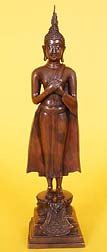 Contemplation BuddhaIn this pose, Both arms of the Buddha lie flat against the chest, the
Contemplation BuddhaIn this pose, Both arms of the Buddha lie flat against the chest, the
palms of both hands facing in, with right arm on outside of left arm.
The Contemplation Buddha signifies quiet determination and patient
understanding.
Alms Bowl Buddha / Begging Buddha
Arms bent at elbows, holding an alms bowl at chest level. This statue
signifies compassion and caring for all beings. Contrary to what many
think, monks (and the Buddha) did NOT beg for food. Instead, they
collected alms. The difference is that collecting alms allows for those
GIVING the alms to make merit (meaning, to acquire good karma). Devout
Buddhists in Asia will prepare and give food to monks in the morning on
their alms rounds.
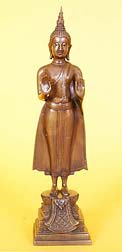
Repelling The Ocean / Preventing the Relatives From Fighting
This statue has two meanings based on two different stories. The first
meaning of Repelling The Ocean comes from a story when the Buddha
visited Bihar state in India. A hermit unleashed a wall of water hoping
to cause a flood, but the Buddha used the power generated from
meditating to stop the water from flooding the area. The Forbidding The
Relatives from Fighting is related to a period in the life of the Buddha
where relatives of his father had an argument with relatives of the
Buddha’s mother over water, as one of the rivers that both sets of
relatives normally depended on was starting to run dry. The Buddha
raised his right hand to draw attention to their own bickering and asked
them what was ore important; water, or their family relations?
Differences In Leg Positions
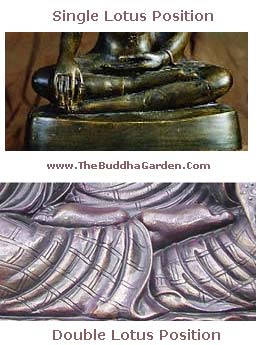 Leg Positions
Leg Positions
In general, the Buddha is depicted as sitting with the legs crossed.
This makes a “triangle” shape to the image; the knees making the two
bottom points of the triangle shape, while the tip of the head makes the
top point of the triangle. The significance is that a triangle shape is
more “grounded” or has a more solid foundation.
There are two positions for crossed legs, namely with the right leg
resting above the left leg in the Single Lotus Position, or with both
knees pointing downward and the ankles tucked on top of one another in
the Double Lotus Position.
But there are a few postures that are not seated with crossed legs,
namely the Maitreya Buddha, where the “Buddha of the Future” sits in a
chair Western style. Also, there is a story of how a monkey and an
elephant visited to make offerings to the Buddha, and in those images he
is depicted sitting in a chair as well. there are standing Buddhas, and
in Thailand, one of the most beloved forms is of the Walking Buddha
statue, which is exclusive to the Sukhothai period of Thai art.
Thai Buddha Poses For The Day Of The Week :
In Thailand each day of the week is associated with a particular Buddha
pose, and “your” pose is determined by which day of the week you were
born. (The Thai zodiac puts as much importance on the day of the week -
Monday, Tuesday, Wednesday, etc. - as on the actual date or month). So
everyone born on a Monday would have one special posture, while everyone
born on a Thursday would have a different posture, etc. Thus, everyone
in Thailand knows which day of the week they were born.
If you have ever been to a Thai temple, then you might see an area where
there are 8 (not seven) small Buddha statues set aside, often with
small bowls next tot them where you can make merit by putting money into
those bowls. The money is then used to help maintain the temple. You
make merit by donating in the bowl of the statue that represents the day
on which you were born. Why 8 instead of 7 when there are only 7 days
in a week? You’ll see in a moment.
Sunday: The Buddha stands with arms crossed over the
stomach, right hand over the left, with the back of the hands facing
outward. The eyes are open and this is a pose of mental insight.
Monday: The Protection Buddha
Tuesday: The Reclining Buddha
Wednesday BEFORE Noon: Alms Collecting Buddha (Thai
people split Wednesday into two different poses - those who are born
before noon on Wednesday and those born AFTER noon).
Wednesday AFTER Noon: The Buddha sitting with a Monkey
and an Elephant, which are giving offerings to the Buddha. This is a
rather unusual pose that many westerners may not have ever seen before.
Thursday: Meditation Buddha
Friday: Contemplation Buddha
Saturday: The Buddha Seated under a Naga (Seven Headed
Serpent), again in Meditation. This pose depicts the meditation Buddha
being protected from falling rain by the spread out hood of the Naga
Statues Commonly Mistaken for the Historical Buddha
Kuan Yin / Avalokiteshvara
One of the images most frequently confused to be an image of the Buddha
are statues of the Chinese Boddhisattva Kuan Yin, as well as the male
counterpart Boddhisattva Avalokiteshvara. Both of these Boddhisattvas
are important to the Buddhist cosmology, as they have forsaken the final
step to Nirvana in order to help mankind reach enlightenment. But
neither is, indeed, the historical Buddha.
You are more likely to come across the female form of Kuan Yin in
Chinese temples, while the male from of Avalokiteshvara is more commonly
encountered in the Mahayana schools of Buddhism found in Nepal, Tibet,
and India.
(Click To View Larger Image)
Happy Buddha / Ho Tai / Prosperity Buddha
Ho Tai, as he is called in Chinese, is often confused with the
Historical Buddha. But a word to the wise; Ho Tai is not the Buddha at
all, but is actually a revered Chinese Monk. He is somewhat akin to the
West’s Santa Claus / St. Nick, since Ho Tai was famous for his Buddhist
sermons and for his bag full of gifts, which he brought to children in
order to reward them for coming to learn about the Dharma.
Part of the reason Ho Tai is confused with the Buddha is because they
both wear robes, and that in certain languages (Thai, for instance) the
vernacular word for the Buddha and for Monks is the same, namely, the
word “Phra.” It can be confusing even for us Thai people, because if
someone were to use JUST the word Phra, we might not know whether they
were referring to the Buddha himself, a monk, a statue of the Buddha, or
even an amulet (religious pendant) featuring an image of the Buddha…
or an image of a highly revered monk!
Ho Tai is often depicted in various forms as well, either with his arms
above his head, reaching skyward, or sometimes holding a bag or knapsack
over one shoulder. But no matter how he is depicted, he always has a
happy face.
The Happy Buddha is often (but not always) depicted with one or more of the following characteristics:
- A �chubby� belly
- A bald head
- Shirtless (or wearing a robe that exposes his whole chest)
- A big smile
- A large bag
- Depicted with smiling children
On the other hand, the Historical Buddha is usually depicted with the following characteristics:
- A graceful body
- Curly hair
- Robes that only reveal one shoulder
- A calm expression
He
replied “NOTHING”! However let me tell you what i have lost: anger,
anxiety, depression, insecurity, fear of old age and death.”
அவர் “எதுவும் இல்லை” என்று பதிலளித்தார்! இருப்பினும் நான் இழந்ததை நான் உங்களுக்கு சொல்கிறேன்: கோபம், பதட்டம், மனச்சோர்வு, பாதுகாப்பின்மை, முதுமை மற்றும் இறப்பு பயம். ”
ಅವರು “ಏನೂ ಇಲ್ಲ” ಎಂದು ಉತ್ತರಿಸಿದರು! ಆದರೆ ನಾನು ಕಳೆದುಕೊಂಡದ್ದನ್ನು ನಾನು ನಿಮಗೆ ಹೇಳುತ್ತೇನೆ: ಕೋಪ, ಆತಂಕ, ಖಿನ್ನತೆ, ಅಭದ್ರತೆ, ವೃದ್ಧಾಪ್ಯ ಮತ್ತು ಸಾವಿನ ಭಯ. ”
“బుద్ధుడిని అడిగారు,” మీరు మధ్యవర్తిత్వం నుండి ఏమి సంపాదించారు? “
అతను “ఏమీ లేదు” అని బదులిచ్చాడు! అయితే నేను కోల్పోయిన వాటిని నేను మీకు చెప్తాను: కోపం, ఆందోళన, నిరాశ, అభద్రత, వృద్ధాప్యం మరియు మరణం భయం. ”
അദ്ദേഹം മറുപടി പറഞ്ഞു “ഒന്നുമില്ല”! എന്നിരുന്നാലും
എനിക്ക് നഷ്ടമായത് ഞാൻ നിങ്ങളോട് പറയട്ടെ: കോപം, ഉത്കണ്ഠ, വിഷാദം,
അരക്ഷിതാവസ്ഥ, വാർദ്ധക്യത്തെയും മരണത്തെയും ഭയപ്പെടുന്നു. ”
त्याने उत्तर दिले “काहीच नाही”! तथापि मी काय गमावले ते मला सांगते: राग, चिंता, नैराश्य, असुरक्षितता, वृद्धावस्था आणि मृत्यूची भीती. ”
তিনি জবাব দিলেন “কিছুই নয়”! তবে আমি আপনাকে কী হারিয়েছি তা বলি: ক্রোধ, উদ্বেগ, হতাশা, নিরাপত্তাহীনতা, বার্ধক্য এবং মৃত্যুর ভয়। “
“બુદ્ધને પૂછવામાં આવ્યું,” તમે મધ્યસ્થીથી શું મેળવ્યું છે? “
તેમણે જવાબ આપ્યો “કંઈ નહીં”! તેમ છતાં, હું તમને કહી શકું છું કે મેં શું ગુમાવ્યું છે: ક્રોધ, અસ્વસ્થતા, હતાશા, અસલામતી, વૃદ્ધાવસ્થા અને મૃત્યુનો ભય. “
उन्होंने जवाब दिया “कुछ भी नहीं”! हालाँकि मैं आपको बता दूँ कि मैंने क्या खोया है: क्रोध, चिंता, अवसाद, असुरक्षा, बुढ़ापे और मृत्यु का भय। ”
اس نے جواب دیا “کچھ نہیں”! تاہم ، میں آپ کو بتاؤں کہ میں نے کیا کھویا ہے: غصہ ، اضطراب ، افسردگی ، عدم تحفظ ، بڑھاپے اور موت کا خوف۔ “
ਉਸਨੇ ਜਵਾਬ ਦਿੱਤਾ “ਕੁਝ ਨਹੀਂ”! ਹਾਲਾਂਕਿ ਮੈਂ ਤੁਹਾਨੂੰ ਦੱਸਦਾ ਹਾਂ ਕਿ ਮੈਂ ਕੀ ਗੁਆਇਆ ਹੈ: ਕ੍ਰੋਧ, ਚਿੰਤਾ, ਉਦਾਸੀ, ਅਸੁਰੱਖਿਆ, ਬੁ oldਾਪੇ ਅਤੇ ਮੌਤ ਦਾ ਡਰ. ”
هن جواب ڏنو “ڪونهي”! تڏهن به توهان کي ٻڌايان ٿو ته آئون وڃائي چڪو آهيان: ڪاوڙ، پريشاني، بيماري، ناامني، عمر جي خوف ۽ موت. “
उनले जवाफ दिए “केही छैन”! यद्यपि मलाई तपाईले हराएको कुरा बताउन दिनुहोस्: क्रोध, चिन्ता, डिप्रेशन, असुरक्षा, बुढ्यौली र मृत्युको डर। “
